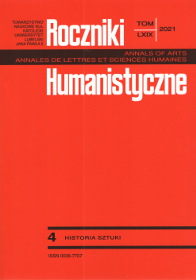Depictions of the Idea of Justice in Mid-18th Century Poland: On the Conflict over the Ostrogski Estate
Abstract
This article aims to show the interrelation between the visual arts, ceremonials and journalistic opinion pieces in the political propaganda of the Polish-Lithuanian Republic during the reign of King Augustus III, using an example which was of vital importance for the public life of that time – the dispute over the entail of the Ostrogski estate. In the satirical Tragic-Comic Scene, the conclusion of the so-called Kolbuszowa Transaction, sanctioning the division of the estate’s entail, was presented as a parody of the courts then operating in the Republic. The illustrations for Piotr Hadziewicz’s dissertation Prawda obiaśniona… conveyed the message that the unity and order of the state must be based upon the observance of its laws, with the King being the guarantor of the legal order. The king established a special commission, known as the Dubno Commission, which was to assess the legal and factual status related to the division of the Ostrogski estate. The committee members strongly emphasised the legality of their actions. They adopted a ceremonial which was modelled on the ceremonies of the Crown Tribunal, an institution deeply rooted in the Polish legal system of that time. The main actors of the “new Tribunal in Dubno”, as Primate Adam Ignacy Komorowski described the Commission, made sure that a uniform message was sent out to the public: that of the harmonious work by the Commission to restore the legal order in the Republic. This message perfectly corresponded with the content of the illustrations and satire of that period.
References
Buchwald-Pelcowa, Paulina. Satyra czasów saskich. Ossolineum, 1969.
Chrościcki, Juliusz A. „Gigantomachia, komety i ulotki. Studia nad ikonografią oblężenia Jasnej Góry w roku 1655”. Studia Claromontana, t. 7, 1987, ss. 121-133.
Gombin. Krzysztof. Trybunał Koronny. Ceremoniał i sztuka. Wydawnictwo KUL, 2013.
Gombin, Krzysztof. „O reminiscencjach konfliktu o ordynację ostrogską w sztuce kręgu Jana Klemensa Branickiego”. Roczniki Humanistyczne, t. 68, z. 4, 2020. ss. 191-203.
Górska, Magdalena. Polonia – Respublica – Patria. Personifikacje Polski w sztuce XVI–XVIII wieku. Wydawnictwo Uniwersytetu Wrocławskiego, 2005.
Konopczyński, Władysław. „Ostrogska ordynacja”. Wielka Encyklopedia Powszechna Ilustrowana, seria II, t. V–VI, Nakład i druk S. Sikorski, 1908, ss. 793-797.
Konopczyński, Władysław. Polska w dobie wojny siedmioletniej, cz. I, W.L Anczyc, 1909.
Muir, Edward. Civic ritual in Renaissance Venice. Princeton University Press, 1986.
Muir, Edward. Ritual in Early Modern Europe. Cambridge University Press 1997.
Palkij, Henryk. „Ceremoniał podczas różnego rodzaju komisji w czasach saskich”. Theatrum ceremoniale na dworze królów i książąt polskich. Materiały konferencji naukowej zorganizowanej przez Zamek Królewski na Wawelu i Instytut Historii Uniwersytetu Jagiellońskiego w dniach 23–25 marca 1998, red. Mariusz Markiewicz i Ryszard Skowron, Zamek Królewski na Wawelu, 1999, ss. 313-314.
Szwaciński, Tomasz. „Rosja a Piotr i Jan Sapiehowie w dobie kryzysu ostrogskiego”. Kwartalnik Historyczny, t. 119, nr 1, 2012, ss. 31-65.
Więcek, Adam. Strachowscy. Z dziejów ilustratorstwa śląskiego XVIII wieku. Ossolineum,1960.
Witwińska, Magdalena. „Rokokowa polichromia Walentego Żebrowskiego w kościele św. Anny”. Kronika Warszawy, nr 1-2, 1972, ss. 53-66.
Copyright (c) 2021 Roczniki Humanistyczne

This work is licensed under a Creative Commons Attribution-NonCommercial-NoDerivatives 4.0 International License.





